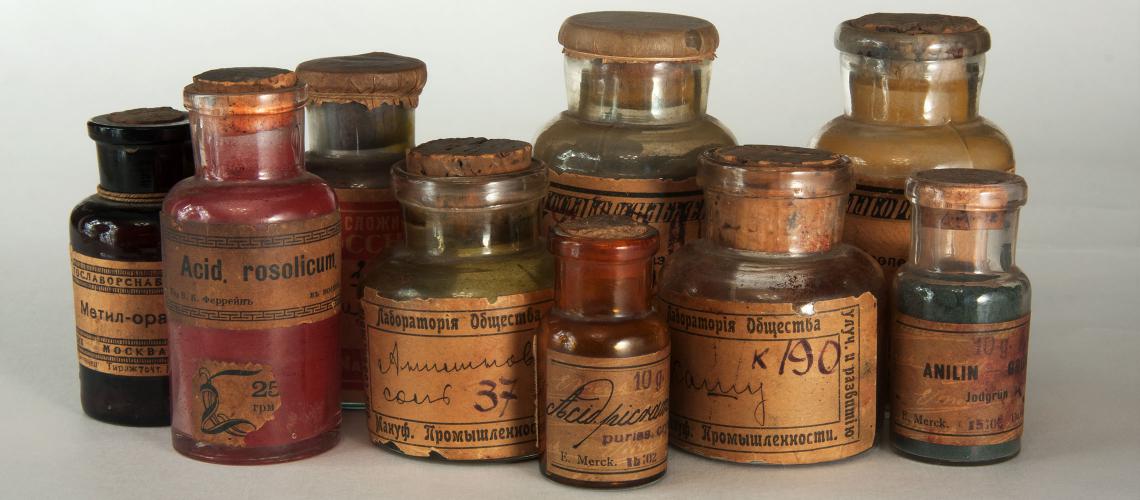Polyester is a category of polymers that contain the ester funcitonal Group in their main chain. As a specific material, it most commonly refers to a type called polyethylene terephthalate (PET). [1] Most of the films used in conservation are made from PET.
Thicknesses of films are often described with microns. 1 micron or μm equals 1 x 10-6m. 1000 micron equal 1 mm or 0,04 inches.
Polyethylene terephthalate (PET)
Polyethylene terephthalate (sometimes written poly(ethylene terephthalate)), commonly abbreviated PET, PETE, or the obsolete PETP or PET-P, is the most common thermoplastic polymer resin of the polyester family and is used in fibres for clothing, containers for liquids and foods, thermoforming for manufacturing, and in combination with glass fibre for engineering resins. It may also be referred to by the brand name Dacron; in Britain, Terylene or, in Russia and the former Soviet Union, Lavsan. [3]
In conservation the BoPETs are widely used. BoPET means biaxially-oriented polyethylene terephthalate and is a Polyester film made from stretched PET. It is known for ist high tensile strength, chemical and dimensional stability, transparenca, reflectivity, gas and Aroma barrier properties and electrical insulation. A variety of companies manufacture boPET and other polyester films under different brand names. In the UK and US, the most well-known trade names are Mylar, Melinex, and Hostaphan. [7]
Mylar®
E. I. DuPont de Nemours in Delaware, USA, first used the trademark Mylar in June 1951 and received registration of it in 1952. It is still the best-known name used for polyester film. The current owner of the trademark is DuPont Teijin Films US, a partnership with a Japanese company. [3]
Mylar® D is a clear (clear is standard), brilliant film which is surface treated on both sides to give superior slip characteristics and excellent handling properties
It is widely used in conservation and storage (Applications: Archival, Graphics, Safety Film, Decorating for laminates, Report covers, microfilm, layout base, membrane switches, protective glazing, labels, overhead transparancies, stationery supplies, graphic arts [4]) The use of Mylar® is approved by the US Library of Congress for Archival and Conservation applications. It is slip treated (pre-treatment) [4]. Polyester film, such as Mylar®, is used for photographic film, storage sleeves, drafting and linings. [5]
Apart from Mylar® D exists Mylar® A, a frosted, milky White translucent polyester film. It doesn't contain plasticizers, so it does not become brittle with age under normal conditions. [4]
Properties of Mylar® are: Dimensional stability, lays flat, chemical resistant, consistent color, good clarity, non-yellowing, non-tearing, heat resistant to 230 degrees C, electrical resistance [4].Resistant to weak acids, weak alkalis, bleach and most organic solvents. Degrades in strong alkalis, strong acids, cresol. [5] This film appears milky or frosted with the increasing thickness of the material. Mylar’s features are an outstanding resistance to moisture and common solvents. It can be used at temperatures from -70 °C to 150 °C. [8]
Mylar® D can come with different finishes and colors: clear, hazy, matte, prepared (gel coated), pressure sensitive, metalized, black, transparent blue, other colors. [4]
Melinex®
Melinex® is a BoPET film from the DuPont Teijin Films family of films. Melinex® Comes with more than 930 Basic grade types covering 90+ market Segments and 140+ specific end uses. [6]
Melinex has a relative temperature index of 140"C and a mechanical RTI of 130°C. It has better ageing behaviour compared to Standard Polyester films which contain a higher level of oligomer. It also has a high degree of puncture resistance, Special mechanical qualities as well as good hydrolytic stability [8].
Hostaphan®
Hostaphan® is a trade name from Mitsubishi Polyester Film. It is a BoPET and heat-set. [9]
Hostaphan is a high-quality crystal clear film and is characterised by a high transparency and extremely minimal cloudiness. It has an excellent mechanical strength and a high degree of dimensional stability. Hostaphan is used for overhead projections, printing (all customary printing processes) and labels. It has distortion-free optics and a good thermal stability. These polyester films are provided with bonding agents on one or both sides for water-soluble printing and coatings. [8]
The properties are: extremely high tensile strength and tear resistance, impact and abrasion resistance, dimensional stability, resistance to heat and cold, excellent suitability for printing, metallisation and lamination, good barrier to aromas, gases and water vapour, resistance to common organic solvents, oils, greases and many inorganic substances,
resistant to mould and bacteria, freedom from plasticisers, odours and flavours, base material suitable for food contact (details on request), excellent electrical insulation
available with a variety of physical properties and surfaces (on this site there are quite a few data gathered). [9] Hostaphan® also comes with a siliconised surface which can serve as a release film. Mitsubishi Polyester Film also provides a lot of data sheets
Cronar®
Cornar® is a polyester photographic film base produced by DuPont. It is used since 1955 in graphic arts, Imaging and medical industries. All Cronar® products are heat-treated for superior resistance to size change and temperature. [10]
Trade names of Polyester films without known exact composition
Timecare® Polyester HCL
Timecare® is a trade name from Conservation by Design. HCL stands for High Clarity Laminate. It is a laminate of polyester and virgin polyethylene. It combines the strength of Polyester with the weldability of Polyethylene. It passes the P.A.T. standards. [11]
Timecare® Crystal Polyester Type 1 and 2
Timecare® is a trade name from Conservation by Design. It is not evident if they are equally using BoPET for the films. Type 2 is easier to weld than type 1 and it can be welded at a lower temperature. Compared to Timecare® Polyester HCL it is clearer but has a higher static cling.
References
[1] Wikipedia Polyester
[2] Wikipedia Polylactic acid
[3] Wikipedia Polyethylene terephthalate
[4] Professional Plasics: Mylar
[5] Cameo: Polyester film
[6] Professional Plasics: Melinex
[7] Wikipedia BoPET
[8] J. Schwarz: Engineering Polyester films (Mylar, Hostaphan, Melinex), 2012
[9] Mitsubishi Polyester film: Hostaphan® Polyester films
[10] DuPont: Cronar
[11] Description of a Timecare HCL Product on CXD Website



